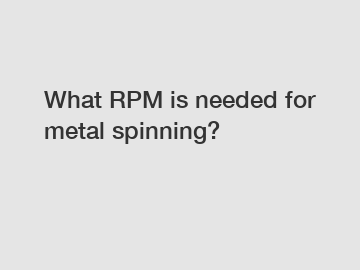Jan. 30, 2024
Machinery
What RPM is Needed for Metal Spinning?
Metal spinning is a versatile and effective metalworking technique used to create seamless, hollow cylindrical or conical shapes from flat metal discs or blanks. This process involves rotating the blank on a spinning lathe while applying pressure to shape it against a form or mandrel. One crucial factor in achieving a successful metal spinning operation is the proper selection of the rotational speed or RPM (revolutions per minute). Determining the ideal RPM involves considering various factors such as the material being spun, the desired shape, and the experience of the metal spinner.
Choosing the right RPM for metal spinning is essential since it directly impacts the overall quality of the formed part. While there is no definitive RPM that applies to all projects, several factors guide metal spinners in finding an appropriate speed.

Material Selection and Thickness.
The type and thickness of the metal being spun significantly influence the RPM. Generally, harder metals require slower speeds, while softer materials can tolerate higher RPMs. A metal spinner must consider the properties of the material and its response to the forming process to prevent excessive strain or deformation. For instance, aluminum, which is relatively malleable, can be spun at higher RPMs than stainless steel, which is stiffer and requires slower speeds.
Forming Process and Shape Complexity.
Different shapes and design complexities require varying RPMs during the metal spinning process. Simple cylindrical or conical shapes can usually be spun at higher speeds without compromising the metal's integrity. However, when forming intricate or asymmetrical shapes, reducing the RPM helps the metal spinner maintain control over the shaping process, ensuring smooth and accurate results.
Experience and Skill of the Metal Spinner.
The experience and skill level of the metal spinner also play a crucial role in selecting the appropriate RPM. Experienced metal spinners develop an instinct for determining the ideal speed based on factors such as the material and the desired shape. They often rely on their knowledge and expertise to fine-tune the RPM during the spinning process. Novice spinners, on the other hand, may require more guidance and experimentation to find the right rotational speed.
Testing and Adjusting RPM.
Finding the optimal RPM for a metal spinning project often involves a process of trial and error. The metal spinner may start with a lower RPM, observe the forming process, and gradually increase the speed until the desired shape is achieved. Testing different rotational speeds allows the metal spinner to gauge the material's behavior and make adjustments accordingly. Continuous experimentation, combined with experience and knowledge, helps metal spinners refine their RPM selection for future projects.
Contact Us.
In conclusion, selecting the right RPM for metal spinning is a careful balancing act that considers several factors such as the material being spun, the desired shape complexity, and the experience of the metal spinner. Achieving the perfect rotational speed ensures the production of high-quality, seamless, and accurately formed metal parts. If you have any further questions or require assistance with metal spinning projects, please do not hesitate to contact us. Our team of experts is always ready to provide guidance and support.
Are you interested in learning more about copper cnc spinning machine, steel spinning machine china factory, spinning lathe manufacturer? Contact us today to secure an expert consultation!
Previous: What is engine used for?
Next: Where can I find the best tips to refill scuba tanks at home?
If you are interested in sending in a Guest Blogger Submission,welcome to write for us!
All Comments ( 0 )